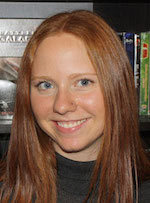Game researcher encourages Wisconsin girls to become next generation of computer programmers
Amanda Ochsner’s got game.
A researcher at the Wisconsin Institute for Discovery’s Games + Learning + Society (GLS) and graduate student in the Department of Curriculum and Instruction, Ochsner studies why there are so few women in the booming game design industry — and she’s working to encourage Wisconsin girls to get into games, too.

Amanda Ochsner
Ochsner first developed an interest in games as an editor for a games website based in San Francisco, where she reviewed games made for and marketed toward adolescent girls.
She didn’t like what she saw.
“They were formulaic, low-budget games where you would go through pretty mundane everyday tasks like doing chores and going to sports practice,” she says. “There wasn’t too much in terms of being able to explore a real identity. I was disappointed and frustrated by those, so I started looking around at other things I might be able to do with games.”
After joining GLS, Ochsner began studying what motivates women to pursue a career in game design — and also what makes them drop out of the industry. By analyzing online conversations and interviewing female game designers, she’s found that many women struggle with the lack of mentors or role models in the industry.
Ochsner’s goal is to ultimately develop frameworks for designing classroom curricula or after-school learning clubs for girls. “Are there after-school spaces that we can design? Or are there ways we can redesign digital media and technology courses in high schools and undergraduate programs that support women better and help them?” Ochsner says.
“We specifically reached out to girls saying programming and code is really fun and exciting — it’s not all of these stereotypes that you may have been led to believe.”
Amanda Ochsner
For the past year, Ochsner has worked with an after-school club in the New Glarus, Wisconsin, school district designed for students interested in computer programming and game design. Ochsner helps students learn to create their own games.
“When I started working with them about a year ago, it was mostly all boys. There were a couple of girls who would come only occasionally,” she says. “We specifically reached out to girls saying programming and code is really fun and exciting — it’s not all of these stereotypes that you may have been led to believe.
“Now, this fall, there are between 10 and 12 girls attending the club regularly. That’s a change from zero just one year ago.”
Read more about Ochsner’s work.
—Mary Sussman
Subscribe to Wisconsin Ideas
Want more stories of the Wisconsin Idea in action? Sign-up for our monthly e-newsletter highlighting how Badgers are taking their education and research beyond the boundaries of the classroom to improve lives.



